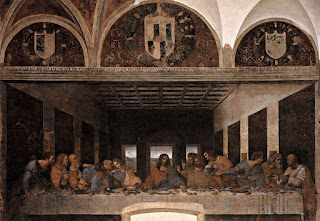Sts Jude Thaddaeus and Simon the Zealot
 |
| Leonardo Da Vinci’s ‘The Last Supper’ |
T
he first point is Jesus chooses the ferment or yeast of ordinary people. When Jesus was scouting for men to be his first disciples aka apostles, or simply the Twelve, what he had in mind was a group of individuals that are teachable, formable like ordinary students. The English word student in Latin is discipulos. Jesus—standing as Rabbi, Sensei, Maha guru, Lao Tzu—formed a bond with the first disciples that is student-teacher-bond and he took every precious opportunity while he was with the Twelve to teach them. No wonder the Twelve apostles were just ordinary working men to start with. Why? Because they were first chosen to learn from Jesus. There is a saying, “You cannot fill a cup that is already full.” The apostles were not the kind of group a modern company might have expected Jesus to call because there was nothing special or spectacular about them. But Jesus painstakingly taught and transformed them into the backbone of the church. He gave them the most extraordinary task one would not imagine he could possibly do, e.g., touching the hearts of people, including the leaders of the mightiest empire ever known, calling them to repentance and faith in the risen Christ. You can be sure that any prediction during the first century Rome that Christianity would spread far and wide would be laughed at. The Christian faith did not take too long but only three centuries when it took over as the official faith of the Roman empire. It all started from the small ferment of Twelve ordinary men.
The second point is what Fr Richard Rohr calls liminal space. It is a teachable space—from the root word "limen," meaning, threshold. In the Catholic Church tradition, a regular visit ad limina apostolorum or simply an ad limina visit by a sitting bishop is an obligation to visit every five years the thresholds of the [tombs of the] Apostles, Sts Peter and Paul, and also to meet with the pope to report on the state of the diocese. The ad limina visit serves the purpose of reigniting the spirit of the disciple as a "student" of the Lord. This is achieved when one goes to the periphery and allows oneself or one's comfort zones to be challenged. The life of the apostles serves as a shining example of persons who learned from the Lord by touching base with him. If God wants to get to us, which God always does, He does it best in these liminal spaces or moments of the cross, e.g., this current pandemic that is teaching us in just a year what could have been learned in a century. Almost all Twelve were martyred and died violently. According to tradition, St Jude suffered martyrdom about 65 AD in Beirut, in the Roman province of Syria, together with the apostle Simon the Zealot, with whom he is usually connected. The ax that St Jude is often shown holding in pictures symbolizes how he was killed. St Simon the Zealot, so the story goes, was martyred by being cut in half with a saw after refusing to sacrifice to the sun god. St Simon is often shown holding a long cross-cut saw which is his chief iconographic symbol.
What is the opposite of limen? Jesus answers by referring to the “leaven of the Pharisees” (Lk 11:12). They are the types of people who avoid sacrifices, pain, and imperfections. They avoid the liminal space—the teachable moment that is necessary for personal transformation and character-building. The liminal space also was the mission itself of the Twelve apostles. An early legend says they cast lots and divided up the thresholds of the world to determine who would go where, so all could hear about Jesus. The liminal space is also the high cost of discipleship because the Twelve suffered greatly enduring violent deaths on account of their bold witness.
The third point is the capstone or keystone that we have heard from the first reading, “built upon the foundation of the Apostles and prophets, with Christ Jesus himself as the capstone” (Eph 2:19-22). Have you ever seen a capstone? You can usually spot this stone in the middle of an arch. The keystone is just an ordinary stone if it does not function as a capstone. The worth of any capstone lies both in its dimension and weight. The dimension, i.e., length, width, and height, gives its proper shape and the weight or density is the pull of gravity which is responsible to hold in place the entire architectural structure securely and enduringly. The capstone is an image ascribed to Jesus alone and rightly so. Why? Because only the promised savior could shoulder such a heavy load. It would be impossible for a human being to carry but not with God. The most difficult part of it is to face the greatest temptation: vain-glory or self-glorification. We recall the temptations of Jesus are all towards self-glorification. There is only a hair-line distinction between capstone and vanity. Using the words of Ecclesiastes, "Vanity of vanities; all is vanity" (Ecc 1:2). The Hebrew word for vanity means "vapor or breath" which does not have any shape or weight. Often we measure our self-worth by measuring one's successes alone but all of that is breath if not seen in relation to Jesus who is the capstone. Every stone laid by the bricklayer is shaped and cut in reference to the capstone. If it isn’t then the builder builds in vain. Ask yourself, “Do my actions of building my life lead me closer to God?” St Ignatius of Loyola asked the same question when he was recuperating after being hit by a cannonball. His life’s edifice crumbled when his right leg was shattered. He felt so worthless. In fact, having broken bones was easier to bear for any soldier like him. But what was more devastating was that his spirit was broken. His conversion was to see his life’s worth anchored back once again in the capstone who is Jesus. Amen. Fr JM Manzano SJ

Thank you Fr. JM for your profound and comprehensive reflection for today. I am always looking forward for your homily every Thursday. It enriches my reflection on the gospel for today. Last week I think I miss your reflection... God bless!
ReplyDeleteYou are most welcome! I will try my best to publish as often as I could! GBU! 😊
DeleteThanks! : )
DeleteThen a sharing...
"...his spirit was broken"... This phrase struck me when I first read your reflection... And I was wondering for it for a while...And today I got an insight... from Fr. Roger, SJ mentioning about the Meditation on Two Standards of Spiritual Exercises in our class...From Narcissism to Humble Service of Christ... I can imagine and feel the pain of the process of his conversion...Not easy... And I can see that this great graced conversion anchored to Christ bears fruit to all people he encountered and through his companions...Example of fermentation of the Kingdom of God...And I'm grateful I was touched by that fermentation... Thanks be to God! And to you too Fr. JM, thank you! for helping in the process of fermentation...And I will extend this process pa more to my community and to those people I will encounter... God bless! Till next homily... : ) OB
Thanks much for your sharing OB! I went to Fr Roger Champoux SJ for spiritual direction as a Jesuit scholastic. Narcissism or self-glorification/vain-glory... I consider this the greatest temptation we all have to face each time and Jesus himself was not exempt from being tempted by the Evil spirit. GBU!
DeleteNow it is my time to say...Following St Paul I have to say "I am jealous with the Divine jealousy." You are blessed to have very good spiritual directors, Fr. Roger and Fr. Daniel... And now I see and believe you are like them too... : )
DeleteOh! I can say I am blessed too somehow... because I was able to encounter, listen and learn from them... : )
And I agree with your last statement...So, be sober-minded; be watchful. Your adversary the devil prowls around like a roaring lion, seeking someone to devour...
Thanks Fr. JM... Now, I'm signing off to silence for our recollection tomorrow. Prayers requested and assured. Have a blessed Sunday! Good night!
Thanks for your kind words! I will go visit also in the cemetery all the Jesuits who accompanied me in my vocation in various levels and to thank them and God for them. GBU!
DeleteHello Fr. JM! I'm back! I recall when we were novices, we would pass by the back gate then pass by the cemetery going to your chapel for the morning mass... And its my favorite path.. its straight and shady because of the trees... I like it when the light would pass through the trees and make a beam of light making me feel the presence of God...And along the way.. we would encounter Our Lady of the Way... And we would greet her with a smile and nod... Is she still there? I can imagine you have a nice time spending with your brothers Jesuits yesterday. These brothers Jesuit of yours resting at peace have surely embraced the liminal space with bold witness to Christ and have passed and shared it unto us, who have to continue the journey and hopefully do the same to those people we encounter... I want to share more... But I'll just stop here and just to say "Saludo ako sa inyong mga Jesuits" especially for living faithfully your vocation. It inspires me a lot to do the same. Thanks for sharing and for being patient,Fr. JM. God bless us! OB : )
DeleteThanks for your recollections of time passed in SHN! We are happy to share this sacred space to you... this is God's gift to us all. Thanks for your words of praises especially for the departed Jesuits. Most of all thank you for taking delight in the image of our Lady! GBU!
DeleteThis comment has been removed by the author.
Delete